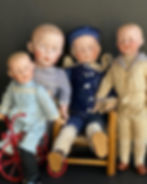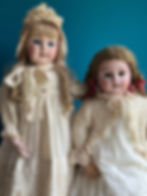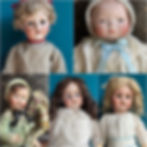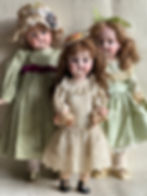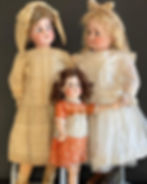How to Spot Repaired or Damaged Bisque Dolls.

Collecting antique dolls can be a rewarding hobby, but it's essential to know how to spot potential issues when making a purchase. Here are some crucial tips to help beginner collectors identify repaired or damaged antique dolls.
Buy from Experienced and Reputable Dealers
Established dealers are your first line of defense against purchasing flawed dolls. They are trained to spot repairs or damage and are more likely to disclose any issues before offering the doll for sale.

Inspect the Doll Yourself
While trusting the dealer is important, it's equally essential to conduct your inspection. Take a close look at all the photos and carefully read the description. You can also ask the dealer to remove the wig and examine the doll's head under a strong light. Bisque is translucent, allowing you to spot any cracks or repairs easily.

Know What to Look For
Not all flaws are equal. Surface lines or firing lines in bisque heads are common and usually don't affect the doll's value. However, hairline/cracks extending from edges or openings, especially around vulnerable areas like eyes, ears, crown, and neck socket, can significantly impact value.

Firing lines are commonly found behind the ears and appear as dark lines. A common term for this defect is “kiln crack”.
Another point of concern when examining bisque parts is the presence of so-called “chips”.

These are small pieces of bisque that have chipped off and are considered damage.
“Wig pulls” refer to flat flakes that sometimes occur on bisque when removing the original wig. These are not considered as significant as other flaws in the bisque.
Examine Eyes Carefully
Eyes are a focal point of antique dolls and can hide potential issues. While shining a light inside the head won't reveal defects due to the plaster blocking the light, visually inspecting the eyes for chips or abnormalities is crucial.

Be Wary of Repairs
Detecting repairs can be challenging, but there are signs to look out for. Chalky residue, shiny areas, or off-color patches may indicate repair work. Additionally, fuzzy eyebrows or irregularly spaced eyelashes could be red flags.
Special Attention to Solid Dome Heads
Solid dome heads pose a unique challenge as you can't shine a light into them without removing the head from the body. Pay close attention to inconsistencies in paint thickness or the direction of painted hair.
Check the Body for Flaws
Don't forget to inspect the doll's body for flaws as well. Look for cracks, chips, or repairs, especially in areas prone to damage, such as joints or extremities. Additionally, pay attention to the doll's stringing, which refers to the method used to attach the limbs to the body. Stringing tends to lose its elasticity over time, and the doll can be difficult to pose.

Private Purchases
When buying from private sellers, take extra care to inspect the doll thoroughly. Be respectful but thorough during the examination and be cautious of tightly glued wigs that may be hiding damage.
By following these guidelines and being diligent in your inspection, you can reduce the risk of purchasing a repaired or damaged antique doll at a high price. Remember, knowledge is your most potent tool when it comes to collecting antique dolls.



